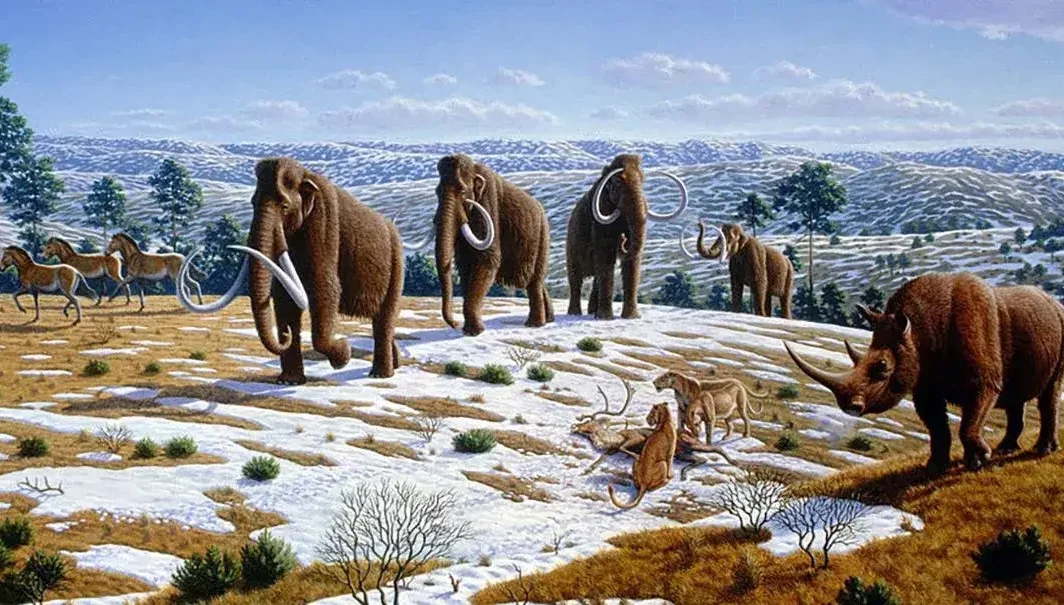Fifty thousand years ago, North America’s landscapes were alive with an astonishing array of enormous creatures. Massive woolly mammoths roamed vast icy plains, while dense forests echoed with the growls of mastodons and saber-toothed cats. Herds of gigantic bison, towering camels, and huge wolves traveled freely, and oversized beavers claimed lakes and rivers. East of the Rockies, giant sloths weighing over a ton lumbered slowly through lush grasslands.
But by the end of the Last Ice Age, most of these remarkable animals vanished, leaving scientists with a deep and enduring mystery: what caused their sudden disappearance?
Humans Versus Climate
Researchers have long debated two main explanations. Some experts strongly believe that early humans were responsible. Humans arrived in North America around the same time as these animals disappeared, about 13,000 years ago. Early settlers might have hunted these creatures heavily, competed with them for resources, or altered their habitats dramatically. The timing certainly fits.
Yet many other scientists point to climate change as the main cause. As the planet warmed, glaciers melted and ecosystems rapidly changed. Animals adapted to cold conditions suddenly struggled as environments became warmer. But this explanation is incomplete, as some animals managed to survive longer than others despite similar environmental changes.
“No single theory explains everything we see,” said Dr. Emily Lindsey, a paleontologist at the La Brea Tar Pits Museum. “The evidence strongly suggests multiple factors working together.”
Indeed, alternative ideas like disease or even a comet strike that disrupted ecosystems remain under consideration. The debate continues because finding solid proof is extremely challenging.
Solving the Puzzle with Modern Science
One significant hurdle in solving this mystery is the poor condition of fossils from that era. Bones found at ancient sites are often broken, weathered, and badly damaged. Over thousands of years, exposure to harsh weather, physical damage, and decay destroy valuable clues, leaving scientists with incomplete evidence.
Despite this, researchers are hopeful thanks to recent advances in science. Modern technology, especially biomolecular techniques, can now uncover hidden information within these damaged bones.
Scientists at the Smithsonian National Museum of Natural History are leading this effort. The museum houses an enormous collection of bones excavated from archaeological sites decades ago, many untouched because of their fragmented condition.
New Life from Old Bones
ZooMS works by identifying collagen proteins preserved in bones. Even though most proteins quickly degrade after death, collagen lasts much longer. Each animal species has a unique collagen “barcode,” allowing scientists to accurately identify even tiny fragments of bones previously impossible to classify.
In a recent groundbreaking study, scientists tested whether the Smithsonian’s bones, excavated between 1934 and 1981 from five archaeological sites in Colorado, still held collagen suitable for ZooMS. Despite doubts due to the age and damage, the results were surprising.
“We found that 80% of these ancient bone fragments contained enough collagen for ZooMS analysis,” explained Dr. Rachel Hopkins, a researcher at the Smithsonian. “About 73% could be identified to at least the genus level.”
Among the identified animals were mammoths, camels, bison, and possibly mastodons. Some fragments could only be narrowed down to broader animal groups due to limited reference databases for North American animals. But even this partial identification offers valuable new insights.
Changing the Game for Archaeology
This discovery transforms the value of previously overlooked museum collections. Bones once considered too fragmented or degraded now hold crucial information. ZooMS provides a cost-effective and rapid method to analyze old bones, helping scientists piece together a more complete picture of the past.
The new technique allows researchers to explore deeper questions about the extinction of giant animals. Knowing precisely where and when these creatures lived, and how quickly they vanished, is critical to understanding why they disappeared. Techniques like ZooMS promise to clarify these questions significantly.
This research also highlights the importance of maintaining museum collections, even if they appear less impressive at first glance.
“Museum collections can be treasure troves,” said Dr. Hopkins. “We need to preserve them because today’s technology can find answers from yesterday’s forgotten bones.”
As funding becomes tighter, museums often struggle to keep vast collections of bones and artifacts. However, this study emphasizes why protecting these collections matters greatly. Old bones stored away for decades can now answer critical scientific questions, shedding light on major events like North America’s megafaunal extinction.
While the ultimate cause of the extinction remains debated, modern methods like ZooMS are bringing scientists closer than ever to solving this ancient mystery. Each bone fragment analyzed is another piece in this fascinating puzzle, slowly uncovering the story of the spectacular animals that once roamed North America—and the factors that led to their sudden disappearance.
